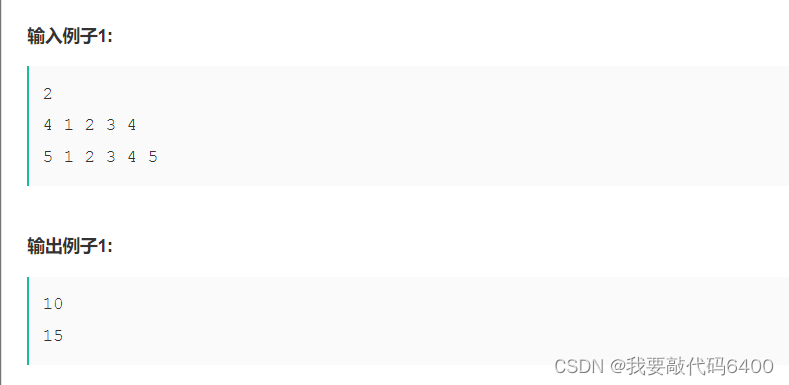-
OJ在线编程输入输出(Java版)
1.[编程题]A+B(1)
输出a+b的结果

可以看到输入和输出是有两行的,有的题目中可能还有三行四行无限行,因此我们要使用while循环来读取数据。
可以看到所有输入都是数字,因此我们就可以选取 hasNextInt()。
- import java.util.*;
- public class Main {
- public static void main(String[] args) {
- Scanner sc = new Scanner(System.in);
- while(sc.hasNextInt()){
- int a = sc.nextInt();
- int b = sc.nextInt();
- System.out.println(a + b);
- }
- }
- }
2.[编程题]A+B(2)

这个方式给了一次输入一共有几个值,分行分次来进行计算
- import java.util.*;
- public class Main {
- public static void main(String[] args) {
- Scanner sc = new Scanner(System.in);
- int t = sc.nextInt();
- for (int i = 0; i < t; i++) {
- int a = sc.nextInt();
- int b = sc.nextInt();
- System.out.println(a + b);
- }
- }
- }
3.[编程题]A+B(3)
输入数据有多组, 如果输入为 0 则结束输入

- import java.util.*;
- public class Main {
- public static void main(String[] args) {
- Scanner sc = new Scanner(System.in);
- while(sc.hasNextInt()){
- int a = sc.nextInt();
- int b = sc.nextInt();
- if(a == 0 && b == 0){
- return;
- }
- System.out.println(a + b);
- }
- }
- }
4.[编程题]A+B(4)
输入数据包括多组。
每组数据一行,每行的第一个整数为这行整数的个数 n。
n 为 0 的时候结束输入。
接下来 n 个正整数,对这 n 个数求和。

- import java.util.*;
- public class Main {
- public static void main(String[] args) {
- Scanner sc = new Scanner(System.in);
- while(sc.hasNextInt()){
- int n = sc.nextInt();
- int sum = 0;
- if(n == 0){
- return;
- }
- for(int i = 0;i < n;i++){
- sum += sc.nextInt();
- }
- System.out.println(sum);
- }
- }
- }
5.[编程题]A+B(5)
输入的第一行包括一个正整数 t 表示数据组数。(一共有几组)
接下来 t 行, 每行一组数据。
每行的第一个整数为这行整数的个数 n。
接下来 n 个正整数,对这 n 个数求和。

- import java.util.*;
- public class Main {
- public static void main(String[] args) {
- Scanner sc = new Scanner(System.in);
- int t = sc.nextInt();
- while (sc.hasNextInt()) {
- int n = sc.nextInt();
- int sum = 0;
- int count = 0;
- while (sc.hasNextInt() && count < n) {
- count++;
- sum += sc.nextInt();
- }
- System.out.println(sum);
- }
- }
- }
6.[编程题]A+B(6)
输入数据有多组, 每行表示一组输入数据。
每行的第一个整数为整数的个数n(1 <= n <= 100)。
接下来n个正整数, 即需要求和的每个正整数。

- import java.util.*;
- public class Main {
- public static void main(String[] args) {
- Scanner sc = new Scanner(System.in);
- while(sc.hasNextInt()){
- int n = sc.nextInt();
- int sum = 0;
- for(int i = 0;i < n;i++){
- sum += sc.nextInt();
- }
- System.out.println(sum);
- }
- }
- }
7.[编程题]A+B(7)
每组数据输出求和的结果

不知道一行有多少个数,因此我们直接一次读取一行,最后把这个数字分开再相加
- import java.util.*;
- public class Main {
- public static void main(String[] args) {
- Scanner sc = new Scanner(System.in);
- while (sc.hasNextLine()) {
- String s = sc.nextLine();
- String[] strings = s.split(" ");
- int sum = 0;
- for (int i = 0; i < strings.length; i++) {
- sum += Integer.parseInt(strings[i]);
- }
- System.out.println(sum);
- }
- }
- }
8.[编程题]字符串排序(1)
对输入的字符串进行排序后输出
输入有两行,第一行n 第二行是n个字符串,字符串之间用空格隔开

- import java.util.*;
- public class Main {
- public static void main(String[] args) {
- Scanner sc = new Scanner(System.in);
- int n = sc.nextInt();
- while(sc.hasNextLine()){
- String s = sc.nextLine();
- String[] str = s.split(" ");
- Arrays.sort(str);
- for(int i = 0;i < str.length;i++){
- if (i != str.length - 1) {
- System.out.print(str[i] + " ");
- } else {
- System.out.print(str[i]);
- }
- }
- }
- }
- }
9.[编程题]字符串排序(2)
多个测试用例,每个测试用例一行。
每行通过空格隔开,有n个字符,n<100

- import java.util.*;
- public class Main {
- public static void main(String[] args) {
- Scanner sc = new Scanner(System.in);
- while (sc.hasNextLine()) {
- String s = sc.nextLine();
- String[] strings = s.split(" ");
- Arrays.sort(strings);
- for(int i = 0;i < strings.length;i++){
- if (i != strings.length - 1) {
- System.out.print(strings[i] + " ");
- } else {
- System.out.println(strings[i]);
- }
- }
- }
- }
- }
总结:
1.如果全部是数字while 中可以使用 hasNextInt()
2.如果全部是字符串,可以一行一行读,使用 hasNextLine()
3.如果一行中既有字符串又有数字,则可以直接读取一行,hasNextLine() 。定义一个String 类型的数组,最后再按空格 spilt() ,或者其他什么要求进行分割就行。再把String 类型的数字转化成 int 类型 :Integer.parseInt()。
-
相关阅读:
ChatGPT与音乐领域的新篇章
什么是泛型,什么是泛型约束
【新学期、新Flag】例文:我的新学期Flag
华为机试真题实战应用【赛题代码篇】-购买水果最便宜的方案(附Java和C++代码实现)
Spring(IOC_DI)依赖注入(配置文件)2022/08/22
CSS 3之 表格
护眼灯哪个牌子更好更专业?2022年高品质护眼台灯推荐
Java眼中的汉诺塔问题【递归】
Ubuntu的C++环境配置
简化部署流程,提升开发效率:介绍 Electron Egg 打包优化
- 原文地址:https://blog.csdn.net/weixin_61567666/article/details/126760993
 https://www.nowcoder.com/test/27976983/summary#question
https://www.nowcoder.com/test/27976983/summary#question